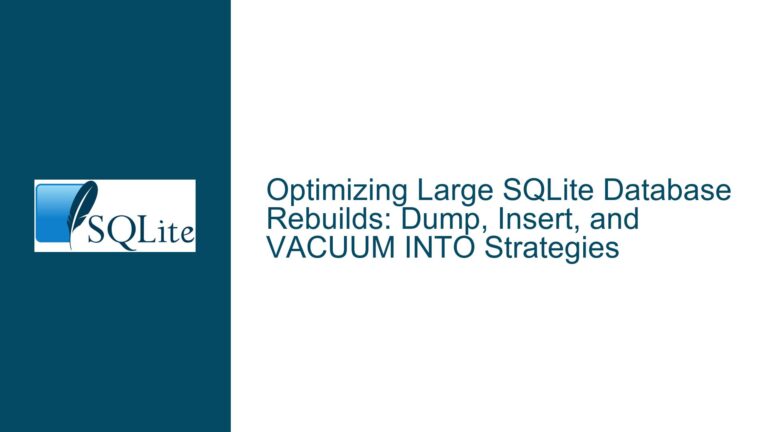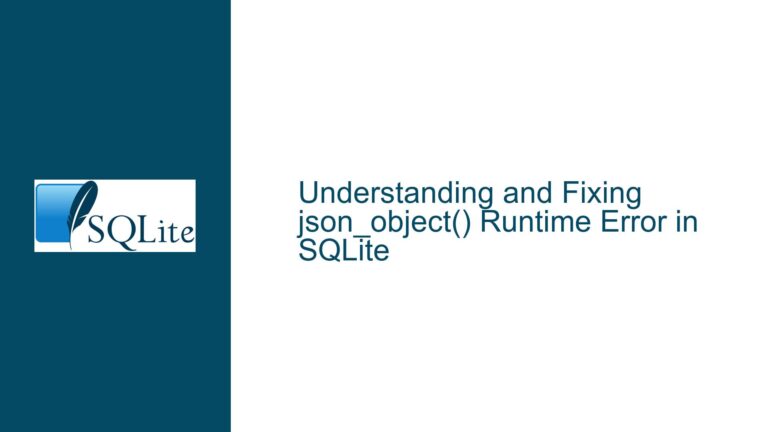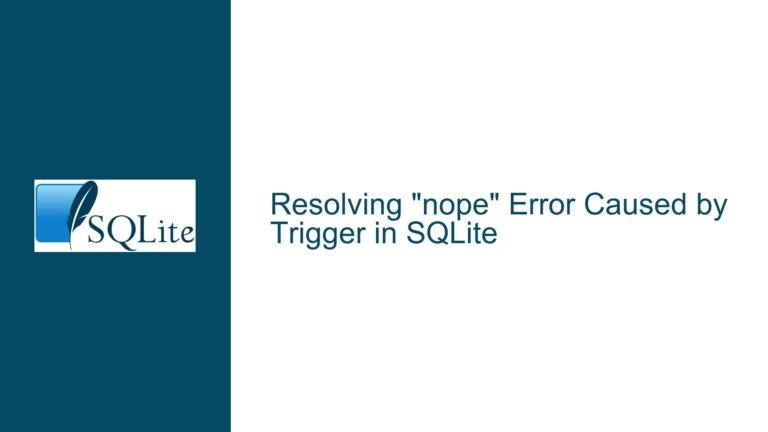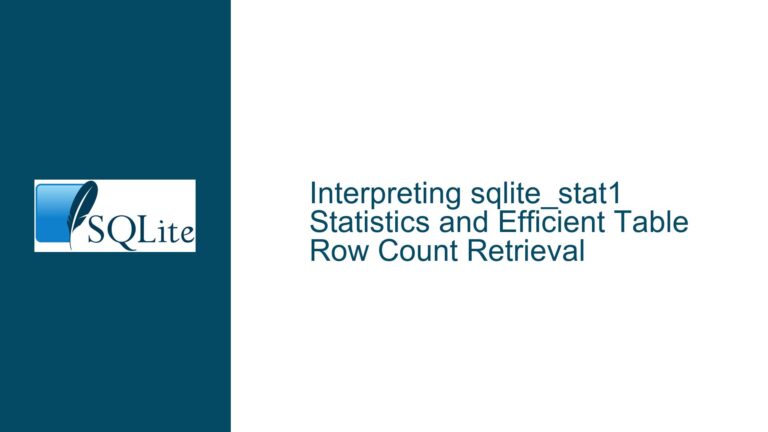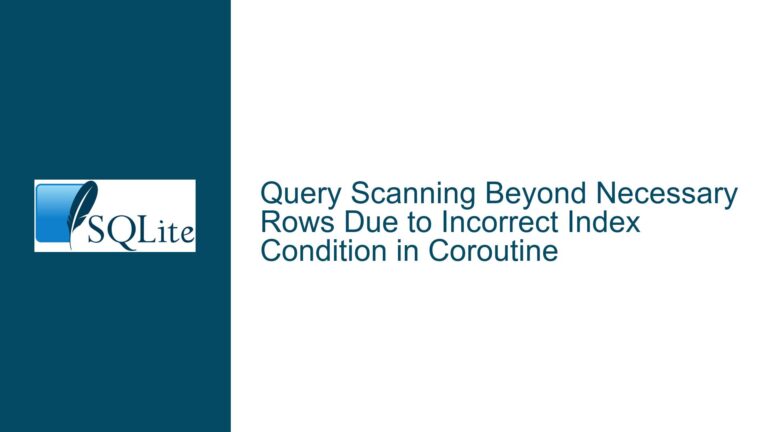SQLite WAL NORMAL Sync Durability on NFS with Single Connection: Risks and Solutions
Understanding SQLite’s WAL Mode, NORMAL Sync, and NFS Constraints
The core challenge revolves around balancing durability guarantees with performance when using SQLite’s Write-Ahead Logging (WAL) mode in synchronous=NORMAL configuration on an NFS-mounted filesystem. This setup is often adopted to mitigate the performance penalty of frequent disk sync operations, especially during bulk DELETE operations. However, the combination introduces nuanced risks tied to filesystem semantics, network reliability, and SQLite’s transactional guarantees.
SQLite’s WAL mode decouples writes from reads by buffering changes in a separate WAL file until a checkpoint operation merges them into the main database. The synchronous=NORMAL setting instructs SQLite to skip explicit fsync operations after transaction commits, relying on the operating system’s periodic flushing of dirty pages to disk. While this reduces latency, it introduces a window where unflushed data in memory could be lost during abrupt system failures.
When deployed on NFS, additional complexities arise. Network File System (NFS) is a distributed filesystem protocol that introduces latency, caching layers, and potential discrepancies in lock management compared to local disks. Even with a single active database connection, the interaction between SQLite’s file operations and NFS’s consistency model can lead to subtle data integrity issues. For example, NFS clients may cache file metadata or delay propagating writes to the server, creating scenarios where SQLite’s assumptions about atomic file updates are violated.
The problem is further compounded by the need to recover from rare but plausible host failures (e.g., kernel panics, hardware faults) while avoiding the performance overhead of synchronous=FULL. The original question seeks to determine whether a single-connection setup on NFS with WAL and NORMAL sync offers a viable trade-off between speed and reliability, given that concurrency-related risks are minimized.
Key Factors Influencing Data Integrity in This Configuration
Four primary factors determine the safety and durability of SQLite databases in this environment:
1. NFS Locking Semantics and Single-Connection Isolation
SQLite relies on filesystem locks to enforce transaction isolation. In WAL mode, a single writer can coexist with multiple readers, but with only one connection active, lock contention is eliminated. However, NFS implementations historically exhibit unreliable or non-atomic lock behaviors. For instance, stale locks may persist after client disconnections, or locks might not be honored consistently across clients. While a single connection avoids intra-process concurrency, NFS server or network hiccups could still cause inter-process lock conflicts if other systems inadvertently access the same file.
2. Write Persistence Guarantees on NFS
The synchronous=NORMAL setting trusts the OS to flush writes to stable storage eventually. On local disks, modern OSes buffer writes in page cache but honor fsync requests rigorously. On NFS, the client’s fsync implementation depends on the server’s adherence to the NFS protocol. If the NFS server acknowledges a write but delays persisting it to disk (e.g., due to its own caching), a power loss event could result in data loss. This is particularly critical for WAL files, which must be durably written before transactions are considered committed.
3. Network Reliability and Partial Writes
Network outages between the SQLite client and NFS server can leave files in inconsistent states. For example, if a client crashes mid-transaction, the WAL file might contain partial writes that are not recoverable. While SQLite’s WAL mode includes checksums to detect corruption, a network partition during a checkpoint operation could leave the main database and WAL desynchronized.
4. Host Failure Modes and Kernel Stability
Kernel panics or hardware failures on the host running SQLite invalidate all software-level durability measures. However, the risk profile changes if the NFS server itself is resilient (e.g., with battery-backed write cache, RAID configurations). If the server guarantees that acknowledged writes are durable, synchronous=NORMAL becomes safer, as the client’s lack of fsync is offset by the server’s persistence mechanisms.
Mitigation Strategies and Configuration Best Practices
To minimize data loss risks while retaining performance, adopt the following measures:
1. Validate NFS Server Configuration for Write Persistence
Ensure the NFS server uses a filesystem with journaling (e.g., ext4, XFS) and a write-back cache backed by uninterruptible power. This reduces the likelihood of server-side data loss after a write acknowledgment. Test the server’s response to fsync using tools like dd followed by sync to verify that writes are not merely cached in volatile memory.
2. Enforce Strict File Locking and Lease Settings
Configure the NFS server and client to use NFSv4 or newer, which offers stronger leasing and lock recovery mechanisms. Set the local_lock mount option to all or flock to prevent local lock conflicts. Explicitly disable attribute caching on the NFS mount with noac to ensure metadata (e.g., file sizes, modification times) are updated synchronously, reducing the risk of SQLite misinterpreting file states.
3. Implement Application-Level Transaction Batching
Although the original question rejects batching due to external software constraints, consider grouping DELETE operations into larger transactions where feasible. Each transaction commit in WAL mode triggers a WAL frame write; fewer commits reduce the frequency of potential sync gaps. Use PRAGMA journal_size_limit to cap WAL growth and force periodic checkpoints during idle periods.
4. Schedule Periodic Checkpoints with Full Sync
Use PRAGMA wal_checkpoint(TRUNCATE) during maintenance windows to merge WAL changes into the main database and truncate the WAL file. Combine this with temporary switches to synchronous=FULL during checkpoints to ensure the main database is fully synced after each checkpoint. This hybrid approach limits the exposure of unsynced data to the WAL file alone.
5. Monitor WAL File Size and Checkpoint Health
Unexpectedly large WAL files indicate checkpoint starvation, increasing the risk of data loss. Use SQLite’s wal_checkpoint logging or external monitoring tools to track checkpoint frequency. Consider using the sqlite3_wal_autocheckpoint API to trigger checkpoints automatically after a threshold of WAL frames.
6. Test Failure Recovery Under Realistic Scenarios
Simulate power loss, network disconnects, and NFS server reboots to validate database recovery. After each test, run PRAGMA integrity_check and inspect the WAL file for residual frames. Use the sqlite3_analyzer tool to audit database and WAL consistency.
7. Leverage SQLite’s Backup API for Redundancy
Use online backups via sqlite3_backup_init to create copies of the database on a local (non-NFS) filesystem periodically. This provides a fallback in case the primary NFS-mounted database becomes unrecoverable.
8. Evaluate Alternative Sync Modes During Critical Operations
For operations requiring higher durability (e.g., financial transactions), temporarily switch to synchronous=FULL using PRAGMA synchronous=FULL and revert after completion. This allows most operations to benefit from NORMAL sync while enforcing stricter guarantees where needed.
9. Audit Filesystem Mount Options and Kernel Settings
Mount the NFS share with sync to disable client-side write caching, ensuring each write operation blocks until the server acknowledges it. While this degrades performance, it narrows the durability gap between NORMAL and FULL sync modes. Adjust the NFS rsize and wsize parameters to match the server’s capabilities, minimizing partial writes.
10. Document and Enforce a Single-Connection Policy
Prevent accidental multi-connection access by integrating connection pooling with a hard limit of one active writer. Use file-based advisory locks or a dedicated lockfile to enforce this at the application layer, complementing SQLite’s internal locking mechanisms.
By systematically addressing NFS quirks, SQLite’s durability trade-offs, and operational edge cases, this configuration can achieve a balance between performance and reliability. The key lies in rigorous testing, proactive monitoring, and layering mitigations to compensate for the inherent risks of synchronous=NORMAL on networked storage.


